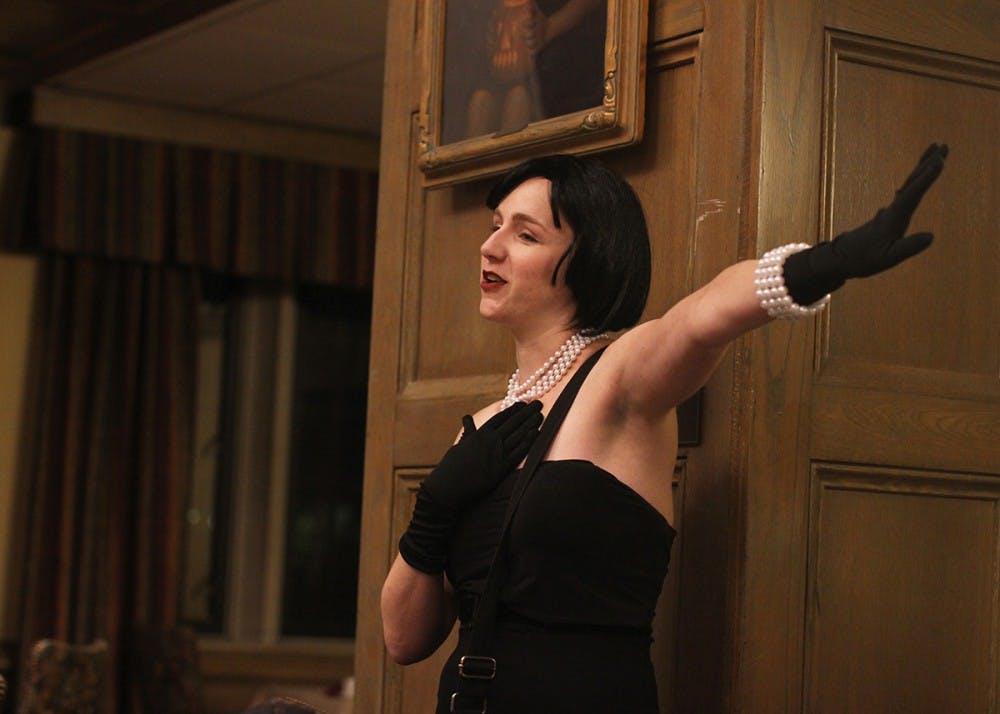Six lanterns lit the way for a procession of about 50 people as they walked through campus Tuesday night. In the glow of the harsh white light, some of IU’s spookiest stories were told.
The Folklore and Ethnomusicology Student Association organized its annual Ghost Walk from 7:30 to 8:30 p.m. A professor, graduate students, an alumnus and a current FESA member told legends and scary stories at various spots around campus.
“It gets people in the Halloween spirit,” sophomore and president of FESA Chloe McCormick said.
McCormick said that none of the stories she chose for the event have been proven to be false and that they are all based on events that IU students have experienced.
She said many of the stories have been drawn from "Haunted Hoosier Halls," which includes stories from IU and haunted houses in southern Indiana.
Krystie Herndon, advisor to FESA and undergraduate academic adviser in the Department of Folklore and Ethnomusicology, said this is the fifth year the event has taken place.
Herndon said the event is family-friendly and that while the stories are spooky, there’s nothing terribly gross about them.
“There are a lot of cool legends around campus, and we thought this was a great way to bring people who were interested in them together,” Herndon said.
The tour took the group to the statue of Herman B Wells, the Indiana Memorial Union's Student Activities Tower, the Tudor Room, Dunn Cemetery and Showalter Fountain.
Here are just a few of the stories they had to tell.
The Tudor Room – “Halloween”
In the Tudor Room, junior Adriane Pontecorvo told the story of the 1938 painting “Halloween,” which depicts a young boy named Jacob holding a jack-o’-lantern. Pontecorvo said the subject of the painting died in a fire several years after the portrait was done.
“This is a pretty sweet kind of innocent child with a jack-o’-lantern,” Pontecorvo said. “Very seasonal. And of course, if you’ve worked with children, that means you cannot trust this child. He’s smiling so peacefully.”
Pontecorvo said Jacob's spirit still lingers around the painting.
“Since he was again, a child, he’s not a malevolent spirit, but he’s definitely a mischievous one, and he wants things to go his way, and when they don’t, he does not take it very well,” Pontecorvo said.
Large medieval tapestries adorn the walls of the Tudor Room. Pontecorvo said that when they had to be taken away to be cleaned one year, glasses would be found smashed, chairs pushed over and place settings strewn about the room every morning.
She said that once the tapestries came back, everything settled down – aside from the occasionally mischievous moment from Jacob.
Dunn Cemetery – The Dunn Family
Standing just outside Dunn Cemetery, Eric César Morales, a Ph.D. candidate in the Department of Folklore and Ethnomusicology, told the story of the Dunn family during the Civil War. Around Morales' neck was a Koru necklace, which he said is a symbol of death and life in the culture of the Māori, the indigenous Polynesian people of New Zealand. At his side was Vaiari Eti, a small dog born in Tahiti.
“This area was first owned by a man named Samuel Dunn,” Morales said. “His wife, one of three sisters, worked during the Civil War. Her and her sisters used to melt down their tools to make bullets. They bandaged the heads of men who were shot.”
Morales said the eldest daughter, Eleanor, married Samuel. Together they owned 160 acres in the Bloomington area.
Morales said that when the Dunn family gave their property to IU, they said the cemetery must belong to the Dunn family forever. George Dunn, son of Samuel Dunn, wanted his family to be able to rest in peace.
“George wrote down that, ‘From the long night of death, his entire family will lie together until the day when they shall all rise from the grave together,’” Morales said.
Morales said that legend has it that occasionally a woman in black can be seen gliding from headstone to headstone. Morales says that this woman is Eleanor Dunn.
Morales said that several years ago, a professional ghost hunter came to the FESA Ghost Walk. He took a photo at midnight of a tree in the cemetery.
“Around that tree was mist, and if you look closely, very closely, in that mist you can see the head and arms of someone reaching out, perhaps from their grave, when the whole family will rise together,” Morales said.
The IU Arboretum – Student Séance
Freshman London Christopher said she was particularly spooked by IU alumnus Kenneth Glynn’s Arboretum story.
Glynn told the story of a group of students who told scary stories in the Arboretum every year. Their last year that they would all be at the University together, they held a séance.
“A lone figure appeared to them in the thick blackness,” Glynn said. “And it looked at them, anger fuming in his eyes. ‘Get off my home!’ and they just booked it.”
The next day, they went back and found a pitch black ashen mark in the grass.
Christopher said she plans on continuing to walk through the Arboretum despite the scary story.
“I go through there every day, and I’m a very superstitious person,” Christopher said.
Indiana University Auditorium — The Stain
The tour concluded at Showalter Fountain where Glynn told the story of a worker who fell to his death building the IU Auditorium.
Glynn said that when the auditorium was being built, a man fell from the scaffolding while looking at a passing plane.
“When he fell he left two things: a crater and a pool of blood,” Glynn said.
Glynn said the pool of blood on the auditorium stage never went away. He said they’ve replaced the floor twice, bleached it and done blessings on it, but it never goes away.
“It will just seep right back up and everyone’s like, ‘All right, throw a rug on it and we’ll call it a day,’” Glynn said.
Glynn also said that janitors who close up the auditorium at night will be visited by ghosts flicking lights back on after the workers turn them off and scaring them in the reflections of mirrors.
“So they’re not malevolent but they are being jerks about it,” Glynn said.




